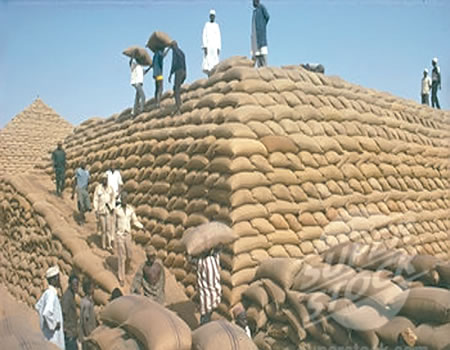However, today, the story is different as groundnut pyramid have not only disappeared but the crop is no longer economically viable, as rice has taken over the position of groundnut in the region.
Thus, rice is one of the staple food consumed in most homes. A rice farmer, Alhaji Yahaya Umar, contended that, “rice has economic value. Venturing into rice farming is lucrative. He said currently, the country needs about 5m metric tonnes to meet its local demand.
‘But what the country produces annually is just three million metric tonnes, leaving it with a deficit of two million metric tonnes.
According to Umar, “every year, the country import about 2m metric tonnes,saying ,’on the average Nigeria spends one billion Naira on rice importation daily(365 billion Naira annually).
The question still remains, ”why spend such an outrageous amount of money importing rice when Nigeria has the potential of growing enough rice to support her growing population and generate surplus that can be exported?”.
It was against this backdrop that when the present administration of President Muhammad Buhari came on board and preached about the need to diversify the economy, many states governments in the region took up the challenge.
Findings gathered that most of the state governments have acquired thousands of hectares of land to boost rice farming in their respective states.
For instance, it was learnt in Kano state, that the state governor, Abdullahi Umar Ganduje remarked that his government had concluded plans to create the enabling environment and provide incentives for the take off of rice farming in large scale,arguing,’ the coming back of groundnut pyramid in the state is no longer feasible.Instead, he disclosed that his government was thinking of setting up rice pyramids.
According to him, the reasons for the setting up the rice pyramid were not far fetched due to the fact that the era of groundnut pyramid is over.
‘Now, we are soon going to be talking about rice pyramid not groundnut pyramid because rice is the crop of the day now.
“The groundnut production you are talking about was in vogue in the years past. Groundnut was produced and exported to foreign lands and then processed and brought back to Nigeria.
“But now, it is a different issue. We have a lot of oil mills that consume the groundnut. So, you will not expect to see the groundnut pyramid as you used to see it because the economic situation has change.
Findings have shown that even some Northern states who were once producing groundnut in large scale have also shifted their attention to Rice cultivation. The reason could not be far from the fact, that the disease that ravaged groundnut farms in the 70s was so enormous making it extremely difficult to cultivate it again. It was said the region lost an estimated 0.75million hectares of groundnut as a result of the epidemic that ravaged the Northern Nigeria with an estimated loss of $250million in regional trade. Thus, states like Kebbi, Katsina, Kaduna, Zamfara, Jigawa and Sokoto are into rice production. For instance, rice production in Kebbi state is now a success story. Findings by the Nigerian Tribune gathered that the state government has earmarked about N10 billion for the establishment of a rice mill in the state. It was said the rice mill has a production capacity of 100,000 tonnes annually as well as silos for storing 18,000 tonnes of paddy and a warehouse for storing additional 12,000 tonnes of paddy.
When operational, it is expected to generate direct and indirect employment for 3,500 people and its procurement will reach out to 50,000 farmers.
Expressing joy over this development , a retired Justice of the Supreme Court and patron of Kebbi State Rice Farmers Association, Uthman Mohammed, said, “Before this time, the rice companies simply came here(Kebbi) to purchase our rice and took it to mill elsewhere.
‘We discussed with the emir that we would appreciate a company to be set up in Argungu for milling our rice, and we are ready to feed such mill.
“Now that the company WACOT, is here, we have gone round to tell our farmers that we now have a rice mill. We urged them to grow more rice so that the mill will produce round the clock. When our people heard about it they were very excited. Many are happy that they no longer have to go seeking for jobs elsewhere because of the job opportunities created in Argungu. It is an interesting thing for me to be a rice farmer.
“I have over 50 hectares of rice field. I harvested over 1,000 bags of rice last year. People come on excursion to my farm to see what I have done there.
Today according to him, most of of the young men and farmers have gone into rice farming.
It was also learnt that rice farming is less cumbersome than groundnut farming. A farmer who pleaded for anonymity remarked that while, rice farming can be done round the clock, especially in swampy areas, close to dam or water reservoir, groundnut farming is seasonal,saying,’ in groundnut farming one does not require plenty water like rice.
The famous groundnut pyramid in Kano which came into being in the 1950s and which flourished up till 1970s was the pride of Northern Nigeria. At its peak, Kano served as the collection centre for groundnut farmers in the region .
Findings revealed that over 2,000 young men were employed at the pyramids. These pyramids were located at Brigade, Dan Agundi, Kofar Mazugal, Dawakin Kudu and Bebeji.
The pyramids were eye catching and a tourist hub for hundreds of people who came from the neighbouring countries like Cameroon, Algeria, Morocco, Tunisia, Agadez , Senegal, Ghana, Benin Republic, Chad,Mali etc to the city of Kano.
Apart from being a major revenue earner for the region, the regional government depended heavily on the proceeds from agricultural produce like cotton, groundnut, assorted grains etc, for its day to day activities as well as the provision of infrastructure.
Today, findings by the Nigerian Tribune revealed that the pyramids no longer exist but instead, the collection centers for groundnuts have been turned to football field, driving field for learners, hide out for criminals among others. For instance, according to a Kano resident, Ibrahim Dan’agundi,”those pyramids no longer exist”. He said the one at Dan Agundi is now being occupied by a bank , while the one at Kofar Mazugal is now the hideout for criminals at night and a football field during the day, while, the one at brigade is now being occupied by a local factory.
However, by 1970s, this agricultural produce (groundnuts) began to experience sharp declined. What was responsible for this trend ? A farmer, Abdullahi Bakane attributed the decline to the emergence of a disease that ravaged most of the farmlands. According to him, many groundnuts farmers lost substantial hectares to the menace. It was learnt that an estimated 0.75million hectares of groundnuts perished as a result of the epidemic that ravaged the Northern Nigeria with an estimated loss of $250m.
It was also learnt that the absence of storage facilities contributed immensely to the disappearance of groundnut. According to him, most of the farmers then had no storage huts. ‘After harvest they took their product directly to the collection centres,he stressed. Elaborating his point, he disclosed that the disease spread fast that and was no assitance to cushionthere. Thus, farmers began to think of an alternative crop in the next farming season.
‘Unfortunately, the government of the day failed to take steps towards addressing the disease which ravaged the region. If you recall last year when we had this problem with tomatoes, both the Kaduna state government and the Federal government took measures to address the situation but it was not the case when this strange disease hit most of our groundnuts farms in the 70s, Bakane stressed.
Also, it was gathered that the emergence of oil contributed to the plight of groundnuts farmers. A groundnuts farmer, Mohamed Abbas, contended that, ‘at that period there was alot of money in circulation.
According to the farmer ,most of the farmers abandoned farming for white collar jobs in the cities,adding that the period also witnessed the emergence of agro-allied industries like leventis farms, PZ, UTC. He stressed that these agro-allied companies went to the farmers directly and made their orders.
Gradually, also ‘we saw a few individuals establishing oil mills and produced items like that produced cooking oil chocolate, soap, and other detergent from the groundnuts they bought from the farmers. Thus, gradually, the pyramids began to disappear, he said.
Again, the creation of additional states by General Yakubu Gowon attributed to the collapsed of the groundnut pyramids. It will be recalled that after the civil war, the then Head of state, General Yakubu Gowon created additional 12 states and Kano was one of the states created by Gowon.
‘So, like the rest of the new states the challenge was not the sustenance of these pyramids but how to provide other amenities like roads, water and electricity for the people . Thus, the creation of these states also contributed to the total collapse of the pyramids, the source affirmed.
But in spite of this disturbing trend, many believed that the pyramid still be brought back. For instance, in a recent international submit agriculture researchers and policymakers were optimistic that Nigeria would bounce back as a leading groundnuts producer in the world.
According to the global food security index, Nigeria is ranked third in the production of groundnuts after India and China. This fact was also collaborated by an agricultural administrator, Nasiru Babamle who believed that nation was still doing well in groundnuts production. According to him, the pyramid might not be there as farmers had evolved different storage techniques to preserve it.
He also said the current federal government drive to ensure that an average Nigerian goes to farm, gives the hope that ground nut farming would soon receive a major boost. ‘If you look around this season many farmers have planted groundnuts. You can see how young girls are selling the boiled one. He believe that with the right policy, the North could have the pyramid back.
His view was also corroborated by a study carried out by an agricultural expert Nautiyal saying, ’Nigeria is one of the countries of the world with a variety of oil seeds notably groundnut, oil palm, soybean and cotton seeds.
‘Vegetable oils is used principally for food (mostly as shortening, margarines, and salad and cooking oils) and in the manufacture of soap and other products.
‘Groundnut is by far the most nutritious oil-seed used in West Africa. The kernels have an average fat and protein content of 75 per cent and an energy value of 360 kcal/100g, compared to 60 per cent and 430 kcal/100 g for soybeans.
According to him, Nigerian groundnuts provides high quality cooking oil and it is an important source of protein for both human and animal diets and also provides much needed foreign exchange by exporting kernels and cake .
He argued that as the population continued to grow the demand for edible oil in many developing countries such as Nigeria would continue to grow.
Thus, groundnut will continue to be important in satisfying this growing demand because it is adaptable to a wide range of environments from sandy soils of the Sahel to favorable irrigated areas.
However, the Kano state governor, Alhaji Abdullahi Umar Ganduje believes that the era of groundnut pyramid is over. In a recent interview with newsmen, he had said his government was making effort to replace the groundnut pyramids with rice pyramids in the state.
According to the governor, it is for this reason the state government is providing the environment that will encourage the massive production of rice, wheat, and tomatoes.
He said the state government would provide rice farmers with the incentives they would need to be able to increase the production of the product.
“The groundnut you are talking about in those years it was the production of groundnut to be exported to the foreign land and be processed and be brought back to Nigeria.
“But now it is a different issue. We have a lot of oil mills that consume the groundnut. So, you will not expect to see the groundnut pyramid as you used to see because the economic situation has change.
“The industrialisation is much better than those days.So, you better stop dreaming of groundnut pyramid now. But when you are talking of rice; that is where we need the pyramids now.
“So, we assure you that in Kano, we are providing an enabling environment for the production of rice, wheat, and tomatoes.’’
Similarly, other state governments in the region seem to be towing the line of Kano. For instance, the rice revolution in Kebbi state is akin to what the Kano state government is planning to do. Also, Katsina State Government says it has invested N200 million in rice and cotton production under the Anchor Borrowers Programme in the state.Dr Abba Abdullahi, the Special Adviser to Governor Aminu Masari on Agriculture, told newsmen in Katsina recently.
“We have rice and cotton farmers that collected the CBN loan under the Anchor Borrowers Programme to boost rice and cotton production and the programme needs supervision.
“We used the funds to supervise and inspect all the rice and cotton farms in the 34 local government areas of the state.
Thus, going by the above fact, it might be difficult for the groundnut pyramids in Kano to find itself back as it used to be. Findings gathered that if respective governments in the region would make use of its comparative advantage in agriculture the North would have rice pyramids, cotton pyramid etc.






